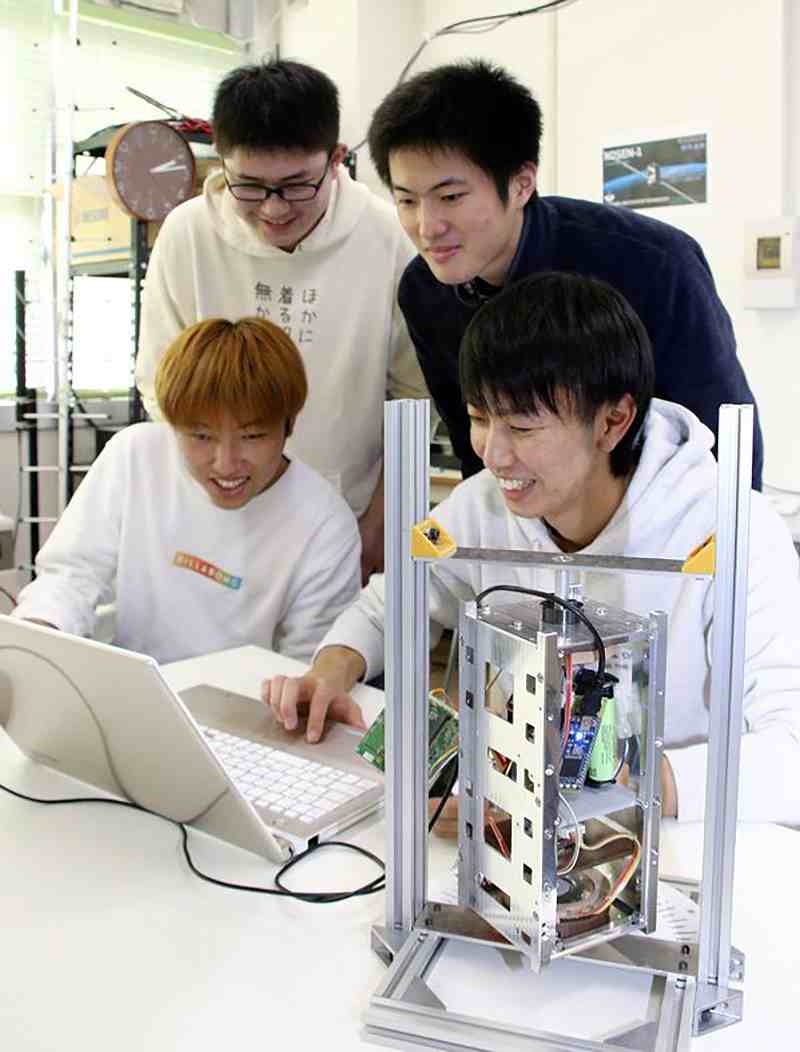Gunma: Student-designed satellite now in orbit to monitor radio waves from Jupiter

Members of the Kosen-1 project team are seen with a model of the satellite at the National Institute of Technology, Gunma College, Maebashi, on Nov. 18.
December 7, 2021
MAEBASHI — A microsatellite mainly developed by a team at the National Institute of Technology, Gunma College, Maebashi, has achieved orbit following a successful launch of the Epsilon-5 rocket that carried it into space Nov. 9.
The Kosen-1 satellite currently orbits 560 kilometers above Earth’s surface. It was designed and assembled mostly by students of the college. Kosen is shorthand for a Japanese word meaning technical college.
“A satellite can be made from scratch, even if you don’t know anything about it,” said Sota Suzuki, 21, a first-year student in the college’s advanced course. “This experience can probably lower the hurdle that many people have about space development.”
The satellite is designed to observe radio waves emitted from Jupiter. Development started in 2018 as a project with the participation of 10 colleges of the National Institute of Technology.
Eleven members who belong to Prof. Nobuto Hirakoso’s laboratory at the National Institute of Technology, Gunma College, were in charge of the satellite’s main components, such as the antenna for observing radio waves and the attitude control system.
Although the satellite is extremely small, measuring 10 centimeters in length and width and 23 centimeters in height, it has about 260 components.
On the night of the launch, an antenna on the roof of the school building received data from Kosen-1. Gathering in the laboratory, the team members were all relieved to confirm that the satellite was successfully put into orbit.
“I wonder what the radio waves are trying to tell us,” said Yusuke Ito, 21, also a first-year student in the advanced course who was already eager to analyze the data.
The team also confirmed that the satellite responded to commands sent from the ground. Kosen-1 so far is operating well. Ensuing experiments would involve deploying the satellite’s antenna and confirming its spatial direction, or attitude, based on images collected by its camera.
“I’m so excited thinking about analyzing the data that will arrive,” said Prof. Hirakoso. “With my students, I want to continue to work on this project, mulling over various possibilities.”
Related Tags
"Features" POPULAR ARTICLE
-

Sanrio to Open Museum in Yamanashi Pref. Dedicated to Founder, Exhibits Include Hello Kitty, Other Characters
-

Autumn Foliage Surrounds Visitors to Tokyo’s Showa Kinen Park
-

My Daughter No Longer Speaks to Me, But I Want to See Her and My Grandchild
-

Kumamoto: Public Bath Refurbished as Library Where You Can Chat, Take Photos
-

Frozen Vegetables: Demand Rises for Convenient, Tasty Domestic Produce
JN ACCESS RANKING
-

Tokyo Economic Security Forum to Hold Inaugural Meeting Amid Tense Global Environment
-

Keidanren Chairman Yoshinobu Tsutsui Visits Kashiwazaki-Kariwa Nuclear Power Plant; Inspects New Emergency Safety System
-

Imports of Rare Earths from China Facing Delays, May Be Caused by Deterioration of Japan-China Relations
-

University of Tokyo Professor Discusses Japanese Economic Security in Interview Ahead of Forum
-

Japan Pulls out of Vietnam Nuclear Project, Complicating Hanoi’s Power Plans

























